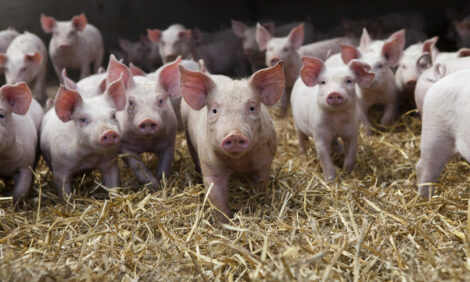



Testing feed-storage time and temperature to reduce virus survival risk
Swine viruses have been shown to hitch a ride in feed and feed ingredients, thereby increasing the infection risk. To address this, the swine industry has applied a range of mitigation techniques, including extended feed storage in a controlled environment.“Current protocols are based on mathematical estimates of half-life,” Scott Dee, DVM, research director for Pipestone Applied Research, Pipestone Veterinary Services, told Pig Health Today. “But there really aren’t any data looking at the amount of time and temperature to inactivate viruses in feed.”
He teamed up with researchers at Kansas State University, South Dakota State University and SAM Nutrition to conduct a demonstration project to zero in on feed-storage requirements to mitigate viral risks, followed by testing a real-world storage setting.1
Controlling storage temperatures
The research started with a demonstration project based on the hypothesis that controlling temperature during storage would reduce the viral risk. The viruses used were Senecavirus A (SVA) as a stand-in for foot-and-mouth disease, porcine reproductive and respiratory syndrome virus 174 (PRRSV) and porcine epidemic diarrhea virus (PEDV).
Samples of organic and conventional soybean meal, lysine, choline and vitamin A (30 g each) were spiked with a 2-mL mixture of the three viruses, each at a dosage of 2 x 105TCID50. Each sample was placed into Rubber Maid® containers and stored at 20° C in conditions to mimic a warehouse. Another set was stored outside in Minnesota during February 2020 to reflect variable conditions (average temperature -8.8° C). For both sets, the storage period was 30 days.
Researchers used polymerase chain reaction (PCR) test and viral bioassay to test the viability of the three viruses. “All five samples stored outside were PCR-positive and contained infectious virus,” Dee said. “All five samples stored inside were PCR-positive for the three viruses but bioassay negative.”
A real-world test
Dee and his fellow researchers wanted to take what was learned from the demonstration project and apply it to more real-world conditions. For that, they used two samples each of organic soybean meal, conventional soybean meal and lysine, placed in metric ton totes (1,000 kg).
Utilizing the “hot spot” model used in past feed-based virus studies, they mixed 10 mL of the three viruses at 5 logs each and froze them at -80° C into large ice cubes. A spiked ice cube was dropped in each tote and left to melt naturally.
Temperature-data loggers were placed outside each of the totes to record temperature during the 35-day storage period. The internal storage involved a climate-controlled warehouse where the temperature ranged from 19° C to 21° C. The external storage was a typical farm shed, “at the mercy of the environment,” and recorded temperatures ranging from 1.7° C to -5.6° C.
PCR tests were conducted on samples pulled on day 0 and day 36 post-inoculation. The samples were collected from 10 probes per tote, mixed together and processed in the same manner as Dee’s feed survival research project, available here.
The findings
For the internal storage, Dee’s team didn’t have much luck finding the virus hot-spot on day 0. “That shows it’s difficult to find,” he noted. “On day 36, we found a few samples that were RNA-positive across the three viruses, but it was still hit or miss.”
Researchers had slightly better luck hitting the hot-spot and finding viral RNA within the external-stored totes. “I think we just got lucky, but it does show some of the strengths and weaknesses of that approach,” Dee said.
For the bioassay, researchers wanted to see how virus survival and infectivity differed between feed totes stored inside and outside. They pooled samples from the internal totes at 35 days post-inoculation – two conventional soybean meal, two organic soybean meal and two lysine. They inoculated pigs in the following manner: oral for PEDV, intra-nasal for SVA and intra-muscular for PRRSV. “So, it was a very robust challenge,” he noted. “We found no evidence of infection as documented by oral fluids or necropsy samples.”
For the external feed totes, they pooled samples from the conventional soybean meal and the organic soybean meal totes. Both sets of samples were positive for all three viruses. They inoculated pigs in the same manner as before. “For the outside samples, it was a different story,” Dee added, “these viruses survive extremely well in outside, cold conditions.”
Temperature versus time
In the end, the study showed that storing feed for an extended period under internal storage conditions, defined as 35 days at a temperature range of 19°C to 21°C, effectively inactivated three swine viruses.
Furthermore, based on the results from the external test, it appears that storage temperature is more critical than time in inactivating the viruses, Dee noted.
“This information pushes the idea of extended [feed] storage to a new level of importance,” he concluded. “It shows that not using half-life calculations and looking at actual virus viability instead, the protocol described here worked very well.
“That’s good news for the industry as we continue to use this strategy to reduce our virus risk in feed.”
| References | ||||
|---|---|---|---|---|
| 1 Dee S, et al. Use of a demonstration project to test the extended storage on viral survival in feed. 52nd Am Assoc Swine Vet annual meeting. 2021;54. | ||||








